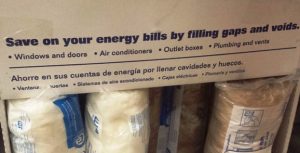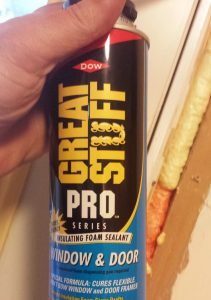When buying new doors & windows (for either new or remodeling) most manufacturers generally require a rough opening size 1/2″ larger than the actual unit size. This requirement is just in case things are not perfectly square or plumb. So how should one finish it off after the unit is installed (fiberglass / foam/ who cares), what happens if the opening is oversized, what about caulking the trim afterwards?
Make sure the unit is centered:
When installing a door in an opening one should make sure it is solidly on the (sub)floor / slab and centered in the opening. When installing a window it should be completely centered in the opening which most accomplish by using shims temporarily at the bottom. Why is this so important? That is so that one can install foam around the unit to not only act as a thermal break but also to help prevent air-leakage (which also means moisture).
What happens if the opening is larger than 1/4″ to 1/2″?

Believe it or not, that is what I found behind the trim in my place – a one plus inch wide gap on both sides (oh and a mouse skeleton looking at me). I know many carpenters that would automatically fill that gap in with a 3/4″ board thus getting down the 1/4″ to 1/2″ gap but guess what – it isn’t always necessary. Fortunately the trim outside easily covered the sheathing and it was shimmed in adequately (well when I finished it was).
So what happens if the gap is to large – well as mentioned above you can always add in a 1x or 2x depending on the gap. Personally if you need to add in a 2x you might want to consider a 1x with a 3/4″ or larger piece of foam – don’t forget about taking care of the sheathing & wrap/flashing details outside.
How shouldn’t you fill the gap?
 Let me first start with these two pictures that you shouldn’t see… Back in the 80’s maybe, by the early to mid 2000’s most everyone was learning better. Still seeing it in displays within the last few weeks… ridiculous. Yes we are talking about fiberglass.
Let me first start with these two pictures that you shouldn’t see… Back in the 80’s maybe, by the early to mid 2000’s most everyone was learning better. Still seeing it in displays within the last few weeks… ridiculous. Yes we are talking about fiberglass.

As an FYI – The picture above is from the 2013 Remodeling Show but they still are using the same displays this year. Another quick point is Anderson Windows specifically call out for foam to be used, not fiberglass – anything like do as we say not as we do? 🙂 As a reminder – since the 2006 IRC one cannot use fiberglass as an air barrier material as shown in this piece highlighting the IRC 1102.4.2 table
How do we deal with the gap?
 Per the codes (in this case the 2015 found in 4.1.1) “The space between window/door jambs and framing, and skylights and framing shall be sealed” & “Air-permeable insulation shall not be used as a sealing material.” In this case the answer is pretty simple – you can only use foam & it should be low expansion. Why not fire-rated, or regular foams? The answer is pretty simple – it can take up to a week to cure / fully expand and is known to deform door jambs & windows preventing them from working right.
Per the codes (in this case the 2015 found in 4.1.1) “The space between window/door jambs and framing, and skylights and framing shall be sealed” & “Air-permeable insulation shall not be used as a sealing material.” In this case the answer is pretty simple – you can only use foam & it should be low expansion. Why not fire-rated, or regular foams? The answer is pretty simple – it can take up to a week to cure / fully expand and is known to deform door jambs & windows preventing them from working right.
But wait, can’t I use fiberglass & “seal” the gap with caulk? Technically you could, assuming you can find a manufacturer that will warranty it and an inspector that would pass it. With that – for windows that have an extension jamb or drywall return, I would encourage you to run a bead of caulk between the window, framing & where the drywall / extension jamb meet.
Caulk & Trim Work:
It used to be the most popular mantra* out there – to save energy caulk around the windows & doors… Unfortunately while the advice is good, it is wrong as the caulking you need to really be worried about is on the exterior & not the interior. It really doesn’t do you much good if you allow cold air to short circuit the insulation.
With that as a builder & a remodeler, the trim should always be caulked (yes even on interior doors.) Why? Well because not only does it look better, but it also allows the paint to adhere better. With that said, while the mantra is getting a beating – if you see air moving curtains / feel a draft in the middle of winter it can definitely help your comfort levels & hey it just might save you a little bit. Just don’t forget to head outside in the spring to solve the real issue which probably includes water leakage.
* Many have been stating for a while that caulking around doors & windows / checking weather stripping isn’t as important as you might have been led to believe. For more on that check out Energy Vanguard’s latest post (and comments) “Winterizing your Home? Don’t caulk the windows” or our piece on FAQ: Are all air leaks equal?

Nice article, Sean. And thanks for the mention and link!
Thank you very much Allison & my pleasure – besides, I couldn’t leave it out as it was what kick started this piece a few days back
Thanks again & I hope you are having a great one
These door and window openings details are breathtaking, and I will use these details in one of my new projects. I am thankful to the writers for sharing this excellent article here.